Fiscal Stamps = Term used to denote issues made for payment of tax, duty or fees other than postage.
Revenue Stamp = Issues made to pay tax or duty other than postage.
List of fiscal/revenue stamps from Victoria onwards:
–Additional Medicine Duty
–Admiralty Court
–Bankruptcy
–Board of Agriculture
–CB Licence Fee Paid (CB Radio Licence)
-Chancery Court
–Civil Service
-Colonial Office Services
–Common Law Courts
-Companies Registration
-Companies Winding Up
–Consular Service
–Contract Note
-Customs
-Diplomatic Service
-District Audit
-Draft or Receipt
-Estate Duty
-Excise Revenue
-Foreign Bill
-Foreign Office
-Foreign Service
-Health & Pensions
-Income Tax
-Inland Revenue
-Insolvency
-Isle of Man Revenue
-Judicature Fees
-Justice Room
-Land Commission
-Land Registry
-Law Courts
-Life Policy
-Magistrates Courts
-Medicine Duty
-Mayor’s Court
-National Health & Insurance
-Northern Ireland
-Passport Office
–Patent Office
-Pedlar’s Certificate
-Police Courts
-Probate Court
-Public Records
-Railway Rates Tribunal
–Revenue stamp with cypher seal and tin strip
-Register House Scotland
–Television Licence
–Transfer Duty
-Travel Identity Card
-Travel Permit
-Unemployment Insurance
-Specimens (no assignment)
Additional Medicine Duty
When medicine duty rates were doubled, these stamps were attached to existing medicine duty labels.
Admiralty Court
The Admiralty Court handles shipping and maritime disputes, these stamps were used to collect court fees.
Bankruptcy
Bankruptcy Petition documents required special revenue stamps for payment of the judicial fees.
Board of Agriculture
These were only issued from 1889 when The Land Commission became The Board of Agriculture. You don’t see many of these around.
CB Licence Fee Paid
CB Licence Fee Paid stamps were issued between 1981 and 1990s on licences to operate CB radios.
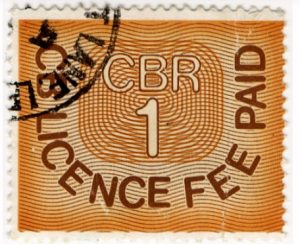
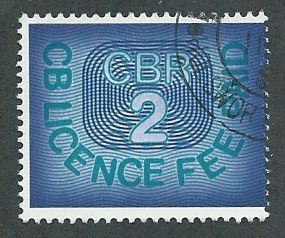
Civil Service
The Civil Service Revenue stamp was used to pay for examination fees to enter the Civil Service and could be bought from Post Offices by prospective candidates.
Common Law Courts
Common Law Courts stamps were used to pay for several fees involved in the system of Common Law after the Common Law Courts (Fees) Act of 1865. The stamps were in use for ten years, being replaced by Judicature Fee stamps in 1875.
Consular Service
These were British revenue stamps used when providing services in embassies and consulates overseas. They were used to pay fees when issuing passports and other services like validating legal documents. Some people collect the cancels and pay a lot of money for rare ones as these have been stamped from all over the world!
Contract Note
Tax on an agreement to purchase shares or sucurites. Introduced as a penny rate by an Act of 1860, extended in 1888 and 1893, and made into a sliding scale 1910 when the use of these adhesives became obligatory (previously, general duty embossed stamps were permitted). Where several sales of stocks were included on one contract note, each sale was taxed, hence the need for a series of values when the rate was originally simply 1d per contract. Most contract notes issue exist with either the overprint inscription in thin or thick letters.
Patent Office
Issued by the Patent Office for payment of fees for registration of patent documents
Revenue stamp with cypher seal and tin strip
Special revenue stamps on blue base paper for the payment of judicial fees were attached to the document. A tin strip was used to attach the two together just like you would use a stapler today.The name of the debtor was written partly on the stamp and partly on the document and then the embossed impression was made.
Cypher adhesive labels were used as a security device to secure the ends of the tin strip. This was the first adhesive stamp from Britain and was used to cover the staple on the reverse of the document. It was line engraved with the royal cypher and its position in the sheet. Originally they bore the Georgean Cypher but in 1837 it was changed to Queen Victoria’s Cypher.
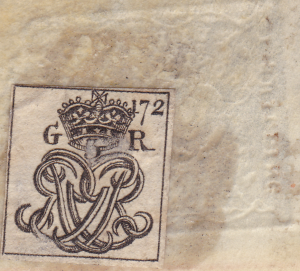
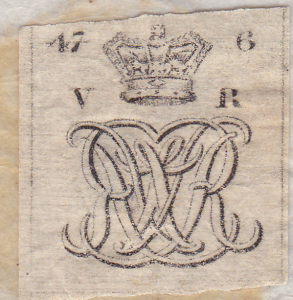
Later in Queen Victoria’s reign the label was changed. The new label was given an engine turned background to the more highly engraved Royal Cypher, it was also given corner letters which indicated the position of the label in the printed sheet.
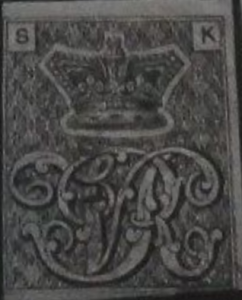
Television Licence
Television licences first appeared in 1946, from 1968 a higher fee was payable for a colour receiver. From 1972 licence stamps were made available at Post Offices; the fee could also be payable directly to the Bristol Licence Office.
Transfer Duty
Tax on the transfer of stocks and shares. This tax was payable only once a year, so if shares were transferred several times in a year, only the first transaction was taxed. The stamps were dated to show their period of validity. Rates were based on the face value of the shares or security – 3d below £25, 6d below £50, 6d per £50 thereafter.
